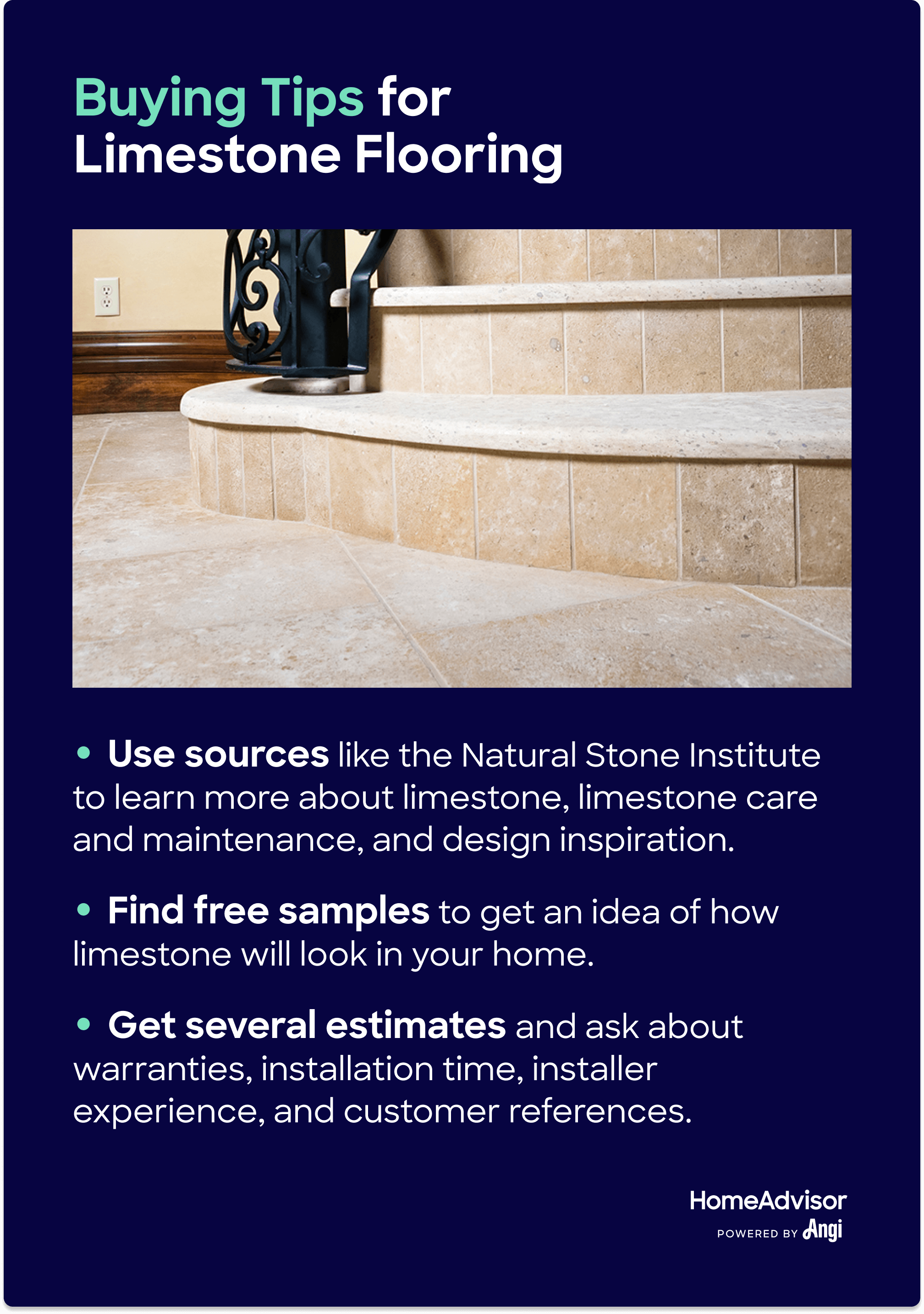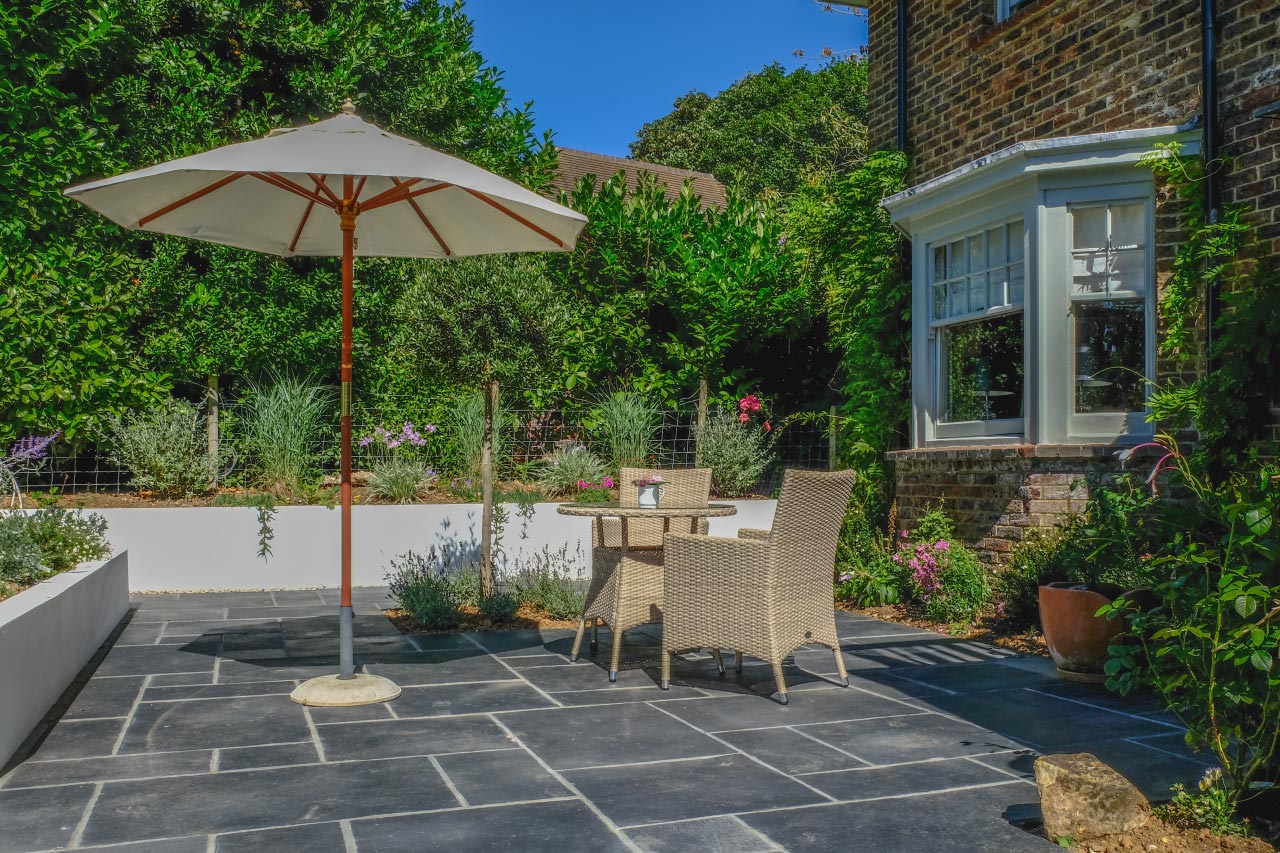How Much Does Limestone Flooring Cost?
Typical Range:
$6,000 - $10,000
Typical Range:
$6,000 - $10,000
Cost data is based on research by HomeAdvisor.
Updated January 19, 2023
Written by HomeAdvisor.While the average limestone flooring cost in a 350-square-foot room is $8,930, most people pay around $6,000 to $10,000. The tile quality, your preferred laying pattern, and the room size can influence the project cost.
| Average Cost | High Cost | Low Cost |
|---|---|---|
| $8,930 | $10,000 | $6,000 |
Standard limestone flooring costs $3 to $10 per square foot. Accent and mosaic limestone tiles can cost up to $30 per square foot. Natural stone tile costs vary on the type of stone, but limestone stands out as an economical option compared to marble flooring costs.
Basic tile limestone can cost as little as $2 per square foot, while honed, mosaic, and veined limestone tile will increase the price. Some installers will charge equipment fees from around $50 to $100 to cover the cost of the wear and tear on saws and saw blades.
Local tile installers cost between $40 and $150 per hour, which adds between $8 and $14 per square foot. For a 350-square-foot room, labor can cost between $5,000 and $8,000.
Labor costs typically cover the following:
Design planning
Material acquisition
Setup
Base application
Laying pattern
Fabrication
Installation
Grouting
Sealing
Cleanup
Slate flooring installation costs can increase if the project includes intricate design or custom cuts to fit the tile properly.
Limestone flooring costs can vary from $750 to $3,500 for a 350-square-foot project, depending on which type of limestone you choose. Mosaic limestone floor is the most expensive because of its intricate design, while honed limestone runs the least expensive. The more work the finish needs increases the costs.
| Limestone Type | Average Cost Range per Sq. Ft. |
|---|---|
| Honed limestone | $3 – $6 |
| Water-worn limestone | $4 – $7 |
| Brushed limestone | $7 – $9 |
| Polished limestone | $6 – $10 |
| Mosaic limestone | $6 – $30 |
Honed limestone costs around $3 to $6 per square foot and has been sanded for a flat matte finish. Honed limestone can have sharp edges, a non-reflective finish, and a softer feel.
Honed limestone can also stain and mask etches better than a polished finish and isn’t slippery, so it works well in various places. It can work for interior floors, interior walls, countertops, backsplashes, and shower walls. Keep in mind that the cost of limestone countertops is about $1,000 to $5,000.
Water-worn limestone costs around $4 to $7 per square foot and is also known as aged limestone or sandblasted limestone. The aged look can provide a more rustic look than other limestone finishes. The rustic look will have a more earthy tone and work well with homes that feature those colors.
Brushed limestone can cost between $7 and $9 per square foot. It’s called brushed limestone because it’s created using a wire brush or steel comb on the stone to add texture to the stone and enhance its color. Brushed limestone offers a smoother finish than tumbled and a more rustic feel than a honed finish.
Polished limestone costs between $6 and $10 per square foot, has a shiny finish, and can make the floor stand out more than other finishes. Polishing limestone means filling in the cavities of the stone and bringing out the subtle colors of limestone. Polish limestone also makes it more slippery, which is something to consider when deciding where to use the stone. Polishing stone floors costs between $5 and $8 per square foot.
Mosaic is the most expensive limestone flooring, costing between $6 and $30 per square foot. Mosaic limestone means cutting limestone into patterns for a more stunning look. You can cut limestone into small intricate pieces or larger ones to create a chevron or herringbone pattern.
Limestone flooring installation costs can increase with factors like the stone type, the size of the room you’re installing limestone flooring, whether the room has steps, and removing existing tiles.
The type of stone or the limestone finish can impact the installation price. Accent and mosaic tiles run the most expensive, with some ranging up to $30 per square foot or more. Installing mosaic tiles requires more time and can increase labor costs.
Different finishes can have higher prices. A honed finish typically costs less than a water-worn, brushed, and polished finish. The drawback of less expensive limestone is that it can be softer and more porous.
Bigger rooms mean more materials and additional labor costs. A typical bathroom is between 40 and 100 square feet, while an average kitchen can be between 240 and 360 square feet. Those costs could add up if you opt to have a mosaic style.
Cutting limestone for steps can mean specific cuts or unusual shapes, so it’s a good idea to overestimate the square footage of a project. Overestimating can also account for any breakages during installation, plus adhering limestone steps could require additional materials. The cost for stone steps is around $700 to $2,000 with installation.
Tile removal costs around $2 to $4 per square foot, and dumping costs from $300 to $1,000, depending on the weight. If you choose to recycle the tile, this can cost $150 to $500. Typically, a local flooring installer will roll removal costs into the installation price.
You can choose the DIY route, but it can be a messy, labor-intensive job with potential danger if not done carefully. Removing tile could damage a ceiling underneath the tile, or you could discover asbestos. Removing cement or adhesive can also require products with toxic and flammable fumes, which need proper ventilation and safety.
Limestone is an appealing flooring option because of its aesthetics, economical cost among stone flooring options, versatility, and value. Limestone can add character to your home, but it does require regular maintenance because of its porous nature. We list some pros and cons of limestone flooring below to help you determine whether it suits your home.
Pros:
Aesthetics: Limestone can have earth tones, textures, and veining to create more interesting flooring.
Cost: Limestone runs less expensive among stone floor options like marble and granite.
Versatility: Limestone fits into several rooms and applications in a house.
Value: Stone flooring, like limestone, can potentially increase your home’s value.
Cons:
Hardness: Limestone is softer than granite and marble.
Slippery: Limestone can be slippery, making it difficult in high-traffic areas.
Cost: Though limestone is a less expensive stone flooring choice, it still costs more than vinyl, porcelain, and carpet.
Maintenance: Limestone needs maintenance with annual sealing and daily vacuuming.
Flooring installation costs can range between $1,500 and $4,500 and is a job for a pro because of the level of detail involved in cutting limestone to fit a space and the work it takes to adhere it to the floor. Cutting stone also requires specific tools and saw blades, which a pro will have. A tile contractor can also remove the existing flooring, which can be messy.
If you have the proper tools and feel comfortable tackling a flooring project, it’s a possible DIY project. You’ll have to pay for the limestone, which can cost between $3 and $30 per square foot.
You can save thousands on labor costs, but you’ll have to cover the cost of grout, caulk, and floor adhesive. A 25-pound bag of dry grouting compound can cover 200 square feet, while a 9-ounce tube of caulk can cover up to 85 linear feet with a 1/8-inch joint width and depth. A 50-pound bag of mortar can cover up to 95 square feet. In addition, materials can cost $100 or more, depending on what you select.
Limestone installation requires about the same work as other types of stone tile. Limestone requires additional care because it can stain easily because of its porous nature. More intricate designs and cuts will take more time to install. Tiling an average-size room can take up to 16 hours from the beginning. Smaller spaces like a 40-square-foot area might take just eight hours.
Limestone can last a lifetime if properly maintained and sealed annually. It also has tremendous durability and can have four times the strength of concrete. However, it isn’t as hard as other stone materials, so it requires a little more attention. Like other stone materials, limestone can chip easily in high-traffic areas. Despite its slightly more fragility than other natural stone tile materials, limestone still stands up well as flooring.
You can find limestone flooring samples between $2 and $10 at your flooring company, or your contractor might provide free samples as part of the entire project. Limestone samples allow you to see different finishes and colors up close. Beware that a sample with veining you like doesn’t necessarily mean you’ll receive limestone like that when you order since limestone varies.
Most experts suggest resealing limestone floors every three to four years, but the frequency can increase to every 18 months in heavy-traffic areas. It’s best to follow manufacturer guidelines to know how often to seal. Limestone tiles need sealing immediately after installation to prevent any staining or damage since it can stain easily because of its porosity. Sealing can also help decrease the slipperiness of limestone.
Limestone flooring can come in white, gray, buff, light beige, dark brown, green, blue, black, yellow, pink, or orange pastel. Limestone most commonly comes in white, beige, and cream. One of the unique things about limestone flooring that makes it an attractive flooring option is that it comes in a variety of colors because of the minerals in limestone.

